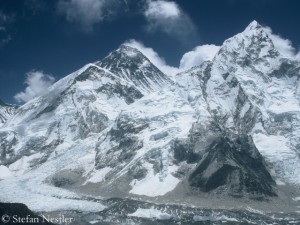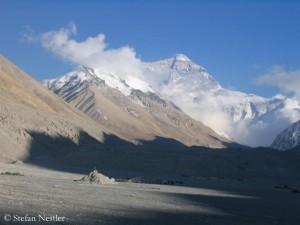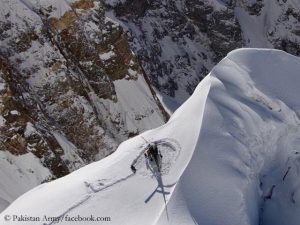Goettler: Violent Sherpas poison atmosphere on Everest
More than 300 Everest dreams are gone. As many climbers returned home empty-handed after their expeditions had been cancelled after the avalanche in the Khumbu Icefall on Good Friday. One of them was David Goettler. The 35-year-old from the German town of Munich had wanted to climb the highest mountain in the world via the normal route on the Nepalese south side without bottled oxygen. Goettler was still acclimatizing when he heard the first still inconsistent reports about the avalanche. “Initially, I hoped that I might still be able to make an attempt”, David told me on the phone. Therefore, he first continued his acclimatization program. “But when I was on the summit of Island Peak (6000er in the Everest region) and wanted to sleep below the highest point, the news came that my expedition and all others would be cancelled.” He returned to Kathmandu.
“David, what made you abandon your project completely? You could have gone to the base camp and try to climb through the icefall by yourself.
Adrian Ballinger of the expedition operator Alpenglow, on whose permit I was listed, flew from Kathmandu to the base camp and spoke with his Sherpas. He also asked them if I could come. After having led his clients with bottled oxygen to the summit, Adrian intended to make an attempt without oxygen, together with me. But the Sherpas told him fairly clearly that there was a small but apparently very influential Sherpa group that threatened violence to anyone who would climb higher than the base camp. Also the base camp staff was threatened, e.g. our cook was told that his family would be hurt. I can never accept this and I do criticize it strongly.
That was just a small group. Most Sherpas were mourning. I can understand every single of them who says that he does not want to climb Everest this season. I do accept it and would never force anyone to fix ropes for me. But as a climber I still want to have the opportunity to consider the risks and then decide for myself whether I go or not. But after we had been told that there was no desire that anyone would climb, we ended our project too. This is an atmosphere in which I feel uncomfortable and in which I do not want to climb.
In 2013, some Sherpas attacked Ueli Steck and Simone Moro in Camp 2. Now a small group threatened violence and exerted pressure. Violence has become a topic on Everest. Do you think that the Sherpas have to tackle this problem because there is obviously a split in their community?
They must solve the problem in any case. These threats and the readiness to use violence are poisoning the atmosphere. The Sherpas are shooting themselves in the foot, they will realize quickly what happens if no more expeditions come. Especially the Sherpas of this small violent group, who work for operators who do not insure their employees sufficiently, would be the first who lose their jobs. I do not know how they would react then.
Last year I got the feeling that most people expected that the Nepalese government should tackle the problem. That did obviously not work. What role can and should the government play at all? Is it not rather the responsibility of the climbing community to solve this problem by itself?
I come to Nepal and pay my permit to the government and not to the Sherpas. So I would hope that the government and the SPCC (Sagarmatha Pollution Control Committee, the management of the Everest National Park) forward this money to the Everest region, or at least that a greater part of it reaches the Khumbu. Each hydroelectric plant, each bridge, each school, each hospital in the Khumbu area is sponsored from Germany, Italy, the United States and other Western countries. I wonder, and I think the most Sherpas also do: Where exactly is the money from the permits for 300 and more climbers, $ 10,000 each? On the other hand, it should go without saying that each client opts for an expedition operator that treats its employees responsibly. If I had decided to take the lowest bidder, I could have saved about 5000 Euros. But I did not know this operator, I did not know which kind of insurance he had for his stuff and how he treated his employees.
The Sherpas – the “Ice doctors”, the high altitude porters and the Climbing Sherpas – are risking their necks in the Khumbu Icefall. Do you understand that they are asking to be paid better for their dangerous jobs?
Their work must be paid in a way that both sides agree. That’s where I am absolutely of the same opinion as the Sherpas. But they need to negotiate the payment before the work starts. Each Sherpa signs a contract with his agency, in which is written exactly how much the amount of insurance is in case of death, how many times he has to climb through the Khumbu Icefall and how much money he gets. If I work as a mountain guide in the Alps and accept a job at Mont Blanc, I also know that there is the slope of Tacul where several other guides have already been killed by avalanches. Nevertheless, I do it for a certain sum of money which I negotiate in the run-up. I know what to expect. Just the Sherpas do know what to expect in the Khumbu Icefall. I was there in three different years, and it always dangerous to the same extent. This year’s disaster was that there were so many climbers at the wrong time in the wrong place. But that could also have happened in all previous years. I also know that I might be killed at the slopes of Mount Tacul. But I cannot strike only because an avalanche has come down and say: Now I want twice as much money, because it’s twice as dangerous. The Sherpas who work on Everest are clever, not uneducated. They have been already there and will return again, because they know it is very well-paid work. If they want more money, it’s okay too. But they should negotiate it before.
For the first time since the start of commercial expeditions on Everest, a season has ended prematurely. Do you think that the big operators will now switch to the north side?
I very much doubt. In one year’s time much will be forgotten. I also do not know if it would be the better choice for commercial operators to go to the north side. There are disadvantages, too. The Chinese government can tell from one day to the next: The mountain is closed now because the Dalai Lama has visited any country. In addition, the possibility to rescue climbers who are in trouble are by far not as good as on the south side, where rescue flights by helicopter to camp 2 are usual. On the south side I also sleep at a lower height in the last camp. I really don’t know which is the lesser of the two evils for a commercial operator.
I hope that the Nepalese south side will work well again, in the sense that the Sherpas, the expedition operators and the individual climbers cooperate and respect each other so that everyone can climb, in all variants.
What about your ambitions on Everest?
I still want to try Everest, at least once. If it is really true that the permit remains valid for five years, I will certainly return to the south side.”










